#Natovenator
Explore tagged Tumblr posts
Text
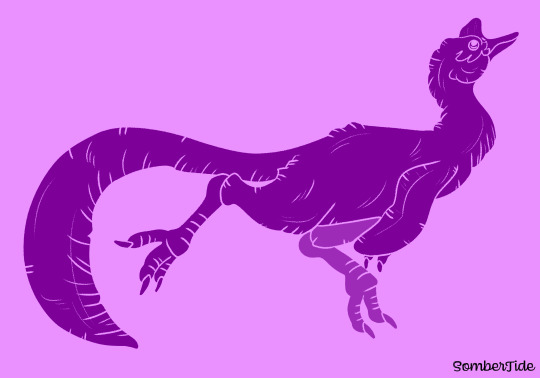
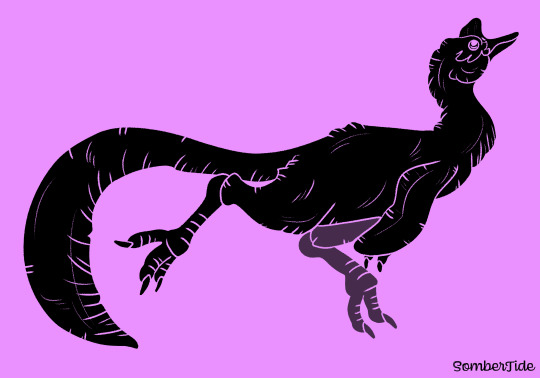
friend wanted to see natovenator
#art#digital art#sombertide art#paleoart#paleontology#dinosaur#natural history#paleo#dino#extinct animal#bird#extinct animals#silhouette#shadowsaurus#theropod#palaeoblr#palaeontology#palaeoart#mesozoic#natovenator
256 notes
·
View notes
Text
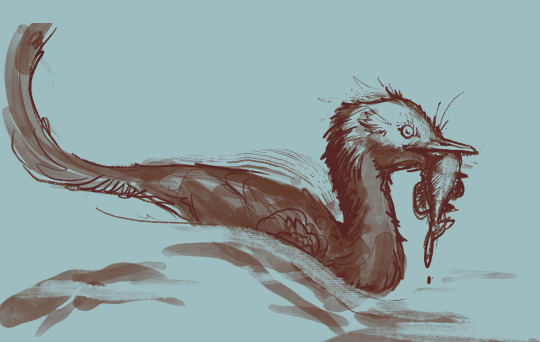
Natovenator polydontus
193 notes
·
View notes
Text

Natovenator joins to my halszkaraptorine bandwagon
19 notes
·
View notes
Text
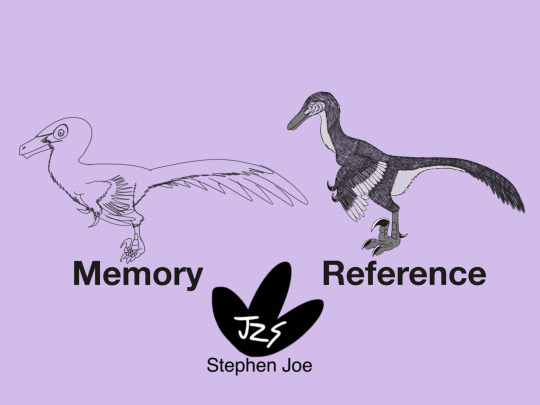
Day 6: Natovenator
Memory vs. Reference time!
#my art#dinosaur#paleoart#myart#dinosaurs#dinosauria#my drawings#Natovenator#halzkaraptorinae#dromaeosauridae#paraves#maniraptora#theropoda#sketchbook app#sketchbookapp#artists on tumblr
8 notes
·
View notes
Text
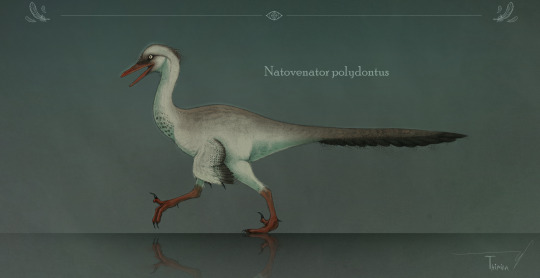
I just keep on forgetting about this platform...
Anyway, here's Natovenator drawing I've made a few weeks ago. This is one of my favourite dinosaurs.
|
•
|
Do not trace or copy my art. You can repost it or use it in any other way ONLY with my permission. You also have yo credit me as an author.
66 notes
·
View notes
Text

Conchoraptor gracilis means “gracile mussel plunderer” and it stands as a reference to an interesting theory on what oviraptorosaurs were doing with their sharp beaks and strong bite-forces. Described in 1986 by renowned paleontologist Rinchen Barsbold, the name Conchoraptor reflects Barsbold’s hypothesis that oviraptorosaurs may have been specialized in cracking open the shells of mollusks. However, Conchoraptor lived in an arid desert environment filled with sand dunes and only intermittent streams. If there were mussels here, there were not enough to feed a population of specialized mollusk-hunters. Conchoraptor was probably more likely to feed on tough vegetation and perhaps small animals, like other oviraptorosaurs. Though if it could find a mussel in the desert, I’m sure it would have had no trouble cracking it open.

Due to its lack of crest, Conchoraptor was originally thought to be a juvenile Oviraptor. However, it had differing anatomy from Oviraptor, especially in its hands. Since then, two dozen specimens of Conchoraptor, including large adults also without crests, have been found. It did seem to have adaptations within its skull for hearing low-frequency sounds, so perhaps it had no need of the crest.

Conchoraptor is known from both the Barun Goyot and the Nemegt Formations of Late Cretaceous Mongolia. In the Barun Goyot, it would have lived alongside fellow oviraptorid Heyuannia, as well as dromaeosaurids like Kuru, Shri, Hulsanpes, and Natovenator, birds like Gobipteryx and Hollanda, alvarezsaurs like Ceratonykus and Parvicursor, and indeterminate sauropods. Ornithischians included the pachycephalosaur Tylocephale, the protoceratopsids Bagaceratops and Breviceratops, and the ankylosaurids Saichania, Tarchia, and Zaraapelta.
A million or so years later, Conchoraptors in the Nemegt Formation would have lived alongside fellow oviraptorid Oksoso, as well as birds like Teviornis and Gurilynia, the ornithomimid Gallimimus, the pachycephalosaur Prenocephale, the hadrosaur Saurolophus, indeterminate therizinosaurids and sauropods, and the tyrannosaur Tarbosaurus.


This art may be used for educational purposes, with credit, but please contact me first for permission before using my art. I would like to know where and how it is being used. If you don’t have something to add that was not already addressed in this caption, please do not repost this art. Thank you!
#Conchoraptor gracilis#Conchoraptor#oviraptorid#theropods#saurischians#dinosaurs#archosaurs#archosauromorphs#reptiles#Late Cretaceous#Mongolia#Barun Goyot Formation#Nemegt Formation#SaritaDrawsPalaeo
28 notes
·
View notes
Text
Natovenator polydontus enjoys a sunset swim by the shores of a shallow sea.
Natovenator was a small, semi-aquatic Cretaceous dromaeosaurid discovered in November 2022, whose features imply a potentially similar swimming/diving lifestyle to many modern waterbirds.
Forgot to post this one earlier, so here it is now!
946 notes
·
View notes
Text
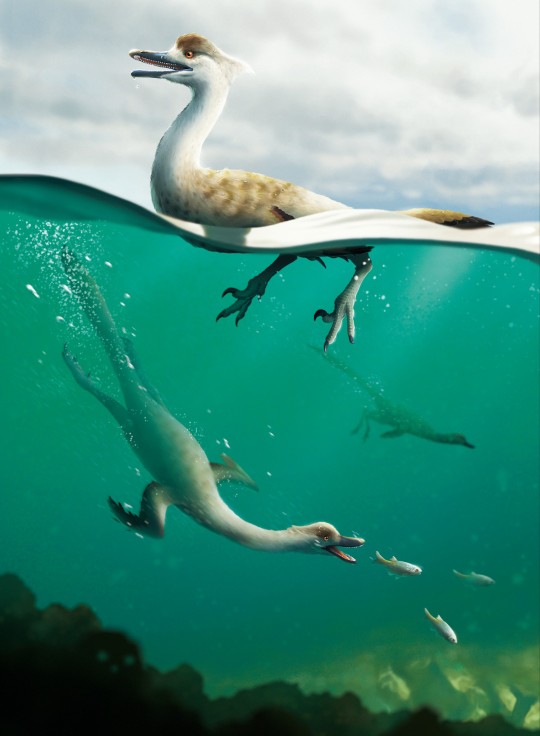
Natovenator
#paleoart#dinosaur#drawing#art#illustration#character#doodle#illust#digital art#palaeoblr#natovenator
1K notes
·
View notes
Text

Halszkaraptorines were a group of small dromaeosaurids known only from the Late Cretaceous of Mongolia. They were odd little raptors with flattened snouts, long necks, and flipper-like arms – features that suggest they were specialized for swimming, making them the second known lineage of semi-aquatic non-avian dinosaurs after the spinosaurids.
This "duck-raptor" interpretation has been a little controversial since it was first proposed in 2017, but we've just gotten some more evidence for it in the form of an entirely new halszkaraptorine.
Natovenator polydontus lived in what is now the Gobi Desert in southern Mongolia, around 72 million years ago. The size of a small duck, about 45cm long (18"), it had jaws full of many needle-like teeth, a long flexible goose-like neck, and a streamlined body with a wide flattened ribcage convergently shaped like those of modern diving birds.
Although it had long strong legs, these don't show much in the way of aquatic specializations and would have been used more for walking and running on land. Instead it may have used its flipper-like arms to propel itself through the water, like modern penguins or auks.
It probably had a lifestyle similar to modern mergansers, swimming and diving in lakes and rivers, and preying on fish, amphibians, and aquatic invertebrates.
———
Nix Illustration | Tumblr | Twitter | Patreon
#science illustration#paleontology#paleoart#palaeoblr#natovenator#halszkaraptorinae#dromaeosaur#raptor#paraves#maniraptora#theropod#dinosaur#art#duckraptor#actual water dinosaurs
605 notes
·
View notes
Photo
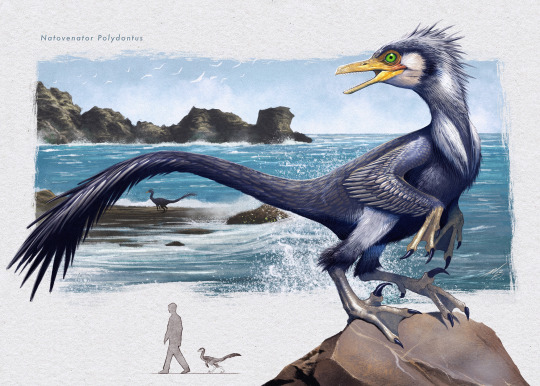
Hi there!
Natovenator from the Late Cretaceous, the most recent dromaeosaurid species found in Mongolia
220 notes
·
View notes
Text
Daurlong vs Natovenator
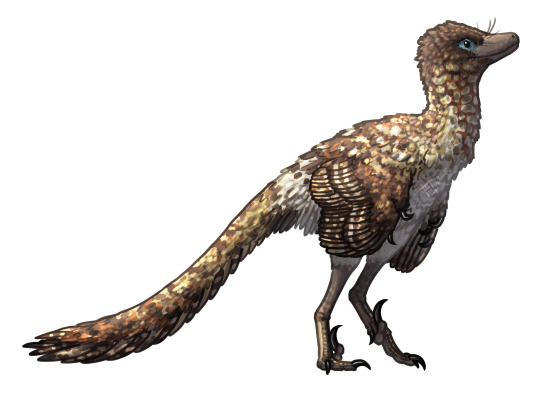
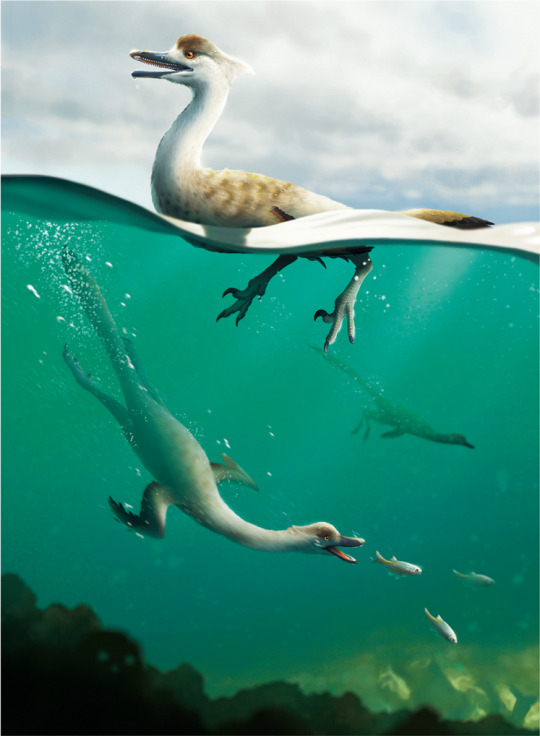
Factfiles:
Daurlong wangi

Artwork by @i-draws-dinosaurs, written by @i-draws-dinosaurs
Meaning: Wang’s Daur dragon (named for the Daur people of Northeast China)
Time: 121 million years ago (Aptian stage of the Early Cretaceous)
Location: Longjiang Formation, Inner Mongolia, China
Daurlong was described in 2022, from a stunningly beautiful fossil that includes the entire body, crushed flat by pressure, and a whole lot of soft tissues like feathers along the back of the neck and even the shape of the intestines! Any part of the digestive system is extremely rare to find in fossils, so Daurlong provides an important glimpse into how the digestive systems of birdlike dinosaurs compare to living dinosaurs today!
Turns out, despite being closely related to the ancestors of modern birds Daurlong’s guts were pretty similar to other, much more distant theropods like Scipionyx instead. That helps fill in a pretty big gap in our knowledge of how the bird digestive system evolved, making this a very scientifically valuable fossil!
That, and it’s just adorable. Look at that lil smiley face!
Natovenator polydontus

Artwork by Yusik Choi, written by @zygodactylus
Name Meaning: Many toothed swimming hunter
Time: 71 million years ago (Maastrichtian stage of the Late Cretaceous)
Location: Hermiin Tsav, Barun Goyot Formation, Ömnögovi, Mongolia
Back in my day, we famously said dinosaurs weren’t aquatic or volant, apart from birds that fit the bill. Fortunately, my childhood is over, and we have both flighted and aquatic nonavians - Natovenator being the next iteration in this strange new reality. Like its cousin Halszkaraptor, Natovenator was a semiaquatic raptor, adapted for moving through the water, potentially with wing flippers to do so. It had a long snout with many teeth adapted for grabbing aquatic life, and it had a long neck similar to modern day diving birds to help it catch prey. It had a streamlined body, allowing it to dive and move through the water efficiently. The long snout was not spatulate, but did curve upward a bit, giving it a vaguely-duck like appearance. The small pointed teeth would have been excellent for grabbing on to struggling fish. Living in the Barun Goyot, a desert ecosystem, Natovenator probably congregated around steady sources of water, such as periodic lakes and oases like those found in modern deserts today. Many mammals are known from the ecosystem, but the real standout stars are dinosaurs: Natoveantor shared its habitat with Ceratonykus, Saichania, Tarchia, Zaraapelta, Gobipipus, Gobipteryx, Hollanda, Bagaceratops, other dromaeosaurs, Conchoraptor, Heyuannia, and unnamed sauropods known only from eggs. Appearing after the Djadokhta and preceding the Nemegt, this environment was a transitional one from the Campanian of Asia to the Maastrichtian, as the environment became more diverse and filled with truly insane numbers of dinosaurs as the period reached its end.
DMM Round One Masterpost
#dmm#dinosaur march madness#dinosaurs#paleontology#dmm round one#dmm rising stars#palaeoblr#bracket#march madness#polls#daurlong#natovenator
160 notes
·
View notes
Text
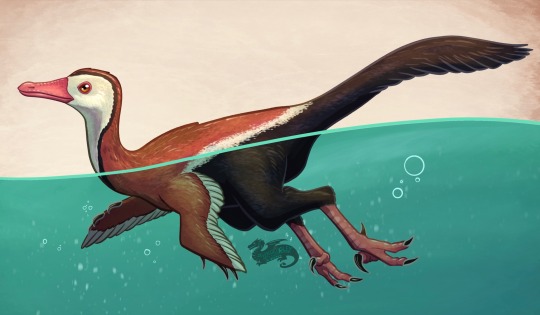
For today’s Fossil Friday, we have Natovenator, a recently described dromaeosaur whose swept back ribs show that it was a regular swimmer!
#dinosaur#natovenator#raptor#dromaeosaur#fossil friday#illustration#art#artwork#digitalart#creaturedesign#drawing#procreate#paleoillustration#paleontology#paleoart#feathered#artist on tumblr
100 notes
·
View notes
Text
Natovenator polydontus Lee et al., 2022 (new genus and species)
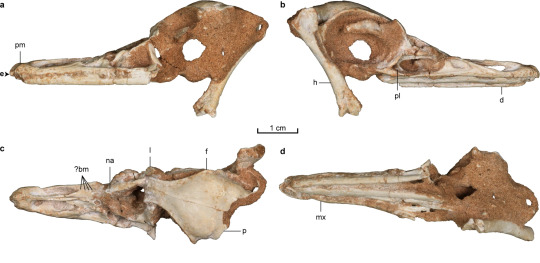
(Skull of Natovenator polydontus, from Lee et al., 2022)
Meaning of name: Natovenator = swimming hunter [in Latin]; polydontus = many teeth [in Greek]
Age: Late Cretaceous (Campanian–Maastrichtian?)
Where found: Barun Goyot Formation, Ömnögovi, Mongolia
How much is known: Partial skeleton of one individual, including a nearly complete skull and parts of the ribcage and limbs.
Notes: Natovenator was a halszkaraptorine dromaeosaurid. Based on features such as numerous teeth, a long neck, and flattened forelimb bones, at least some members of this group have been considered semi-aquatic foragers, though this hypothesis has also been questioned. Natovenator preserves enough of the ribcage (which is mostly unknown in other halszkaraptorines) to indicate that it had a vertically compressed torso with backswept ribs. Its describers interpret these as potential swimming adaptations that streamlined the body, and thus argue in favor of a semi-aquatic lifestyle for these dinosaurs.
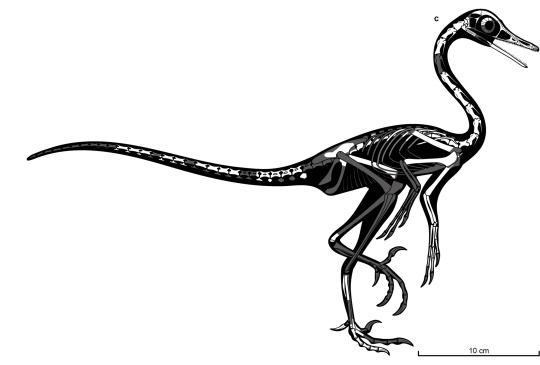
(Schematic skeletal of Natovenator polydontus with preserved bones in white, from Lee et al., 2022)
Reference: Lee, S., Y.-N. Lee, P.J. Currie, R. Sissons, J.-Y. Park, S.-H. Kim, R. Barsbold, and K. Tsogtbaatar. 2022. A non-avian dinosaur with a streamlined body exhibits potential adaptations for swimming. Communications Biology 5: 1185. doi: 10.1038/s42003-022-04119-9
88 notes
·
View notes
Photo
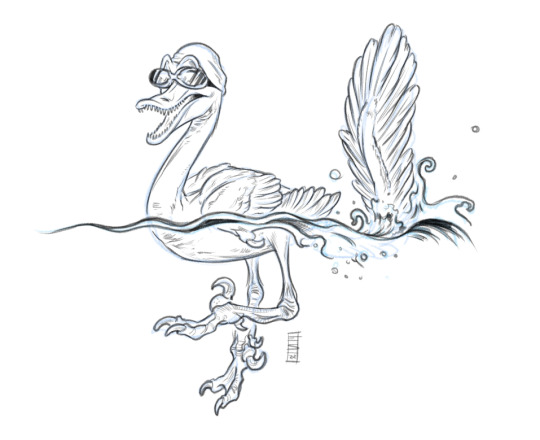
Sketch_Natant Natovenator.
Digital, 2022.
#paleoart#dinosaur#theropod#coelurosaur#raptor#natovenator#toon#digital#sketches & doodles#dromaeosaur
84 notes
·
View notes
Text

Natovenator, one of the newest dinos!
33 notes
·
View notes
Text
I heard about natovenator!! I plan on drawing him today. But for old times sake, take this older sketch of a Halszkaraptor :)
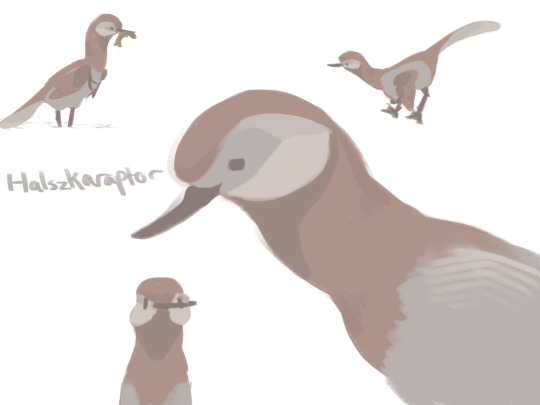
Not incredibly accurate body shape but I still like him
35 notes
·
View notes